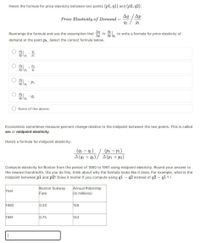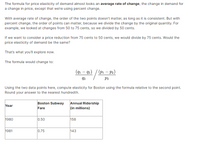
ENGR.ECONOMIC ANALYSIS
14th Edition
ISBN: 9780190931919
Author: NEWNAN
Publisher: Oxford University Press
expand_more
expand_more
format_list_bulleted
Question

Transcribed Image Text:Here's the formula for price elasticity between two points (pl, q1) and (p2, q2):
Aq
Price Elasticity of Demand =
Ap
P1
Aq
Rearrange the formula and use the assumption that
Ap
da
to write a formula for price elasticity of
demand at the point p. Select the correct formula below.
dq
dp lp1
P1
dg
P1
dp lp
• P1
da
• 91
dp p.
None of the above.
Economists sometimes measure percent change relative to the midpoint between the two points. This is called
arc or midpoint elasticity.
Here's a formula for midpoint elasticity:
.5 (n + 9)/P2 - pı)
.5 (p1 + P2)
(१2 - १)
Compute elasticity for Boston from the period of 1980 to 1981 using midpoint elasticity. Round your answer to
the nearest hundredth. (As you do this, think about why the formula looks like it does. For example, what is the
midpoint between pl and p2? Does it matter if you compute using ql- q2 instead of q2- ql ?)
Boston Subway
Fare
Annual Ridership
(in millions)
Year
1980
0.50
158
1981
0.75
143

Transcribed Image Text:The formula for price elasticity of demand almost looks an average rate of change, the change in demand for
a change in price, except that we're using percent change.
With average rate of change, the order of the two points doesn't matter, as long as it is consistent. But with
percent change, the order of points can matter, because we divide the change by the original quantity. For
example, we looked at changes from 50 to 75 cents, so we divided by 50 cents.
If we want to consider a price reduction from 75 cents to 50 cents, we would divide by 75 cents. Would the
price elasticity of demand be the same?
That's what you'll explore now.
The formula would change to:
(а — 2) / (p1 — рә)
92
P2
Using the two data points here, compute elasticity for Boston using the formula relative to the second point.
Round your answer to the nearest hundredth.
Boston Subway
Fare
Annual Ridership
(in millions)
Year
1980
0.50
158
1981
0.75
143
Expert Solution
This question has been solved!
Explore an expertly crafted, step-by-step solution for a thorough understanding of key concepts.
Step by stepSolved in 5 steps

Knowledge Booster
Similar questions
- q3- What is the correct interpretation of elasticty value of 0.5 for Y with respect to X? Select one: a. If X increases by 1 unit, Y increases by 0.5 unit. b. If X increases by 1%, Y increases by 0.5%. c. If Y increases by 1 %, X increases by 0.5 %. d. If Y increases by 1 unit, X increases by 0.5 unit.arrow_forwardNumbers 5 adn 6 need to be answered. The function (8.6) needed in 5b has been included in a separate picture. Please show all work. Thank you.arrow_forwardIf we have a cross-price elasticity of demand of CeD +7.5, which combination of products would best fit with this value? (a) Cabbages and cauliflowers (b) iPhone and iPhone charger (c) Washing powder (for clothes) and washing up liquid (for crockery/cutlery) (d) A chicken microwave meal and a vegetarian microwave mealarrow_forward
- Compute a slope and elasticity of a line, which goes through coordinate points (2,7) and (4,1). Illustrate your results by a graph of this function. Provide a written interpretation of your resultsarrow_forwardIf possible, please include made-up numerical values.arrow_forward-0.06 The short-term demand for crude oil in Country A in 2008 can be approximated by q = f(p) = 1,952,082p where P represents the price of crude oil in dollars per barrel and q represents the per capita consumption of crude oil. Calculate and interpret the elasticity of demand when the price is $62 per barrel. The elasticity of demand for oil is (Type an integer or a decimal.)arrow_forward
- Q1: KSU Products has just carried out a survey of the demand for their guidebooks to spoken Arabic. They have found the following results over the last six months. Sales revenue 356 398 372 360 365 350 Price ($) 4.5 4.0 4.2 4.5 4.3 4.8 a. Estimate an appropriate demand relationship; Q=apb b. Make a forecast of sales revenue for a price of $5, stating any assumptions. c. Éstimate the price elasticity of demand for the data as a whole. d. If price is raised 10 per cent in general terms, what will happen to revenue?arrow_forwardplease help the answers I got were wrong!!!arrow_forwardYour marketing research department provides the following estimated demand function for your product: Qd=500.6-11.4P-0.2INCOME where P is the price of your product and INCOME is average income. Your product is good because If the standard error for the price coefficient is 2.0, its t-statistic will be Therefore, the coefficient is (Round your answer to two decimal places)arrow_forward
arrow_back_ios
arrow_forward_ios
Recommended textbooks for you

 Principles of Economics (12th Edition)EconomicsISBN:9780134078779Author:Karl E. Case, Ray C. Fair, Sharon E. OsterPublisher:PEARSON
Principles of Economics (12th Edition)EconomicsISBN:9780134078779Author:Karl E. Case, Ray C. Fair, Sharon E. OsterPublisher:PEARSON Engineering Economy (17th Edition)EconomicsISBN:9780134870069Author:William G. Sullivan, Elin M. Wicks, C. Patrick KoellingPublisher:PEARSON
Engineering Economy (17th Edition)EconomicsISBN:9780134870069Author:William G. Sullivan, Elin M. Wicks, C. Patrick KoellingPublisher:PEARSON Principles of Economics (MindTap Course List)EconomicsISBN:9781305585126Author:N. Gregory MankiwPublisher:Cengage Learning
Principles of Economics (MindTap Course List)EconomicsISBN:9781305585126Author:N. Gregory MankiwPublisher:Cengage Learning Managerial Economics: A Problem Solving ApproachEconomicsISBN:9781337106665Author:Luke M. Froeb, Brian T. McCann, Michael R. Ward, Mike ShorPublisher:Cengage Learning
Managerial Economics: A Problem Solving ApproachEconomicsISBN:9781337106665Author:Luke M. Froeb, Brian T. McCann, Michael R. Ward, Mike ShorPublisher:Cengage Learning Managerial Economics & Business Strategy (Mcgraw-...EconomicsISBN:9781259290619Author:Michael Baye, Jeff PrincePublisher:McGraw-Hill Education
Managerial Economics & Business Strategy (Mcgraw-...EconomicsISBN:9781259290619Author:Michael Baye, Jeff PrincePublisher:McGraw-Hill Education


Principles of Economics (12th Edition)
Economics
ISBN:9780134078779
Author:Karl E. Case, Ray C. Fair, Sharon E. Oster
Publisher:PEARSON

Engineering Economy (17th Edition)
Economics
ISBN:9780134870069
Author:William G. Sullivan, Elin M. Wicks, C. Patrick Koelling
Publisher:PEARSON

Principles of Economics (MindTap Course List)
Economics
ISBN:9781305585126
Author:N. Gregory Mankiw
Publisher:Cengage Learning

Managerial Economics: A Problem Solving Approach
Economics
ISBN:9781337106665
Author:Luke M. Froeb, Brian T. McCann, Michael R. Ward, Mike Shor
Publisher:Cengage Learning

Managerial Economics & Business Strategy (Mcgraw-...
Economics
ISBN:9781259290619
Author:Michael Baye, Jeff Prince
Publisher:McGraw-Hill Education